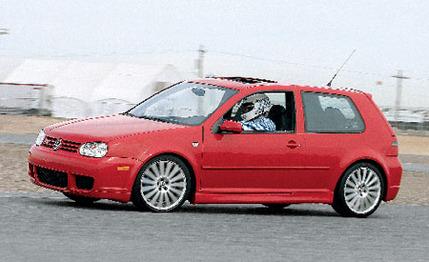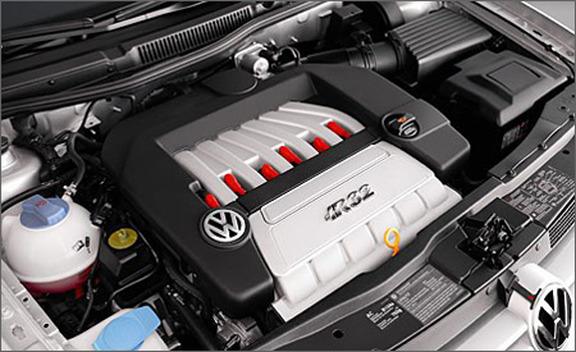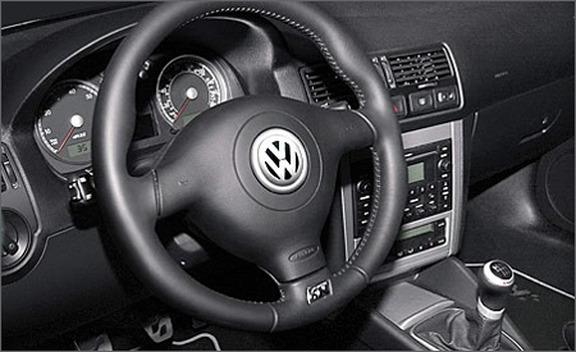
 First Drive Review
First Drive Review
Discounting the squarish designs that dominated autodom until the mid-'30s and the cubism of Borg spacecraft, no manufacturer has mined more glamour and performance from rectilinear conveyances than Volkswagen--at least not in the past couple decades. It was VW, after all, that dignified the econobox back in 1983 with the creation of the first GTI, essentially a Rabbit with attitude.
Comes now the latest and most vehement expression of this tradition, the R32, a GTI so potent that VW refrains from calling it a GTI. Wow. But just where does it fit in the small-car performance pantheon?
We'll get to that in a minute. First, the pedigree. You already know the R32 is a buffed-up Golf. However, it's not the Golf now on sale in Europe, the fifth-generation car. The foundation of the R32 is the previous generation, which is still on sale in the U.S. and will be for some time. The new Golf won't appear here until May 2006.
Still, the "old" platform seems to serve pretty well in this application. Chassis rigidity is hard to fault, and the elements attached to these firm underpinnings are hard to fault, too--except in the hefty sum of the parts. The heart of the R32 is a 3.2-liter DOHC 24-valve version of VW's ingenious VR6. With variable valve timing on both the intake and exhaust cams, this is the most powerful edition of the narrow-angle V-6 yet offered in a Golf: 240 horsepower at 6250 rpm and 236 pound-feet of torque from 2800 to 3200 rpm. Bore and stroke were stretched to expand displacement from 2792 to 3189 cubic centimeters, although it's still a long-stroke design and thus not a high-rpm screamer. But midrange response is robust, the revs soar eagerly to the 6500-rpm redline, and the sounds emerging from the twin exhausts--Wagner on a baritone sax--are worth the substantial price of admission.
The VR6 is bolted to a six-speed manual transmission, which is in turn integrated with VW's Haldex all-wheel-drive system. It's the same system used in the Audi TT, although VW calls it 4MOTION, rather than Quattro. Names notwithstanding, it gives the R32 something no previous GTI has possessed: traction at all four corners, enhanced by 225/40 Z-rated Goodyear F1 tires on 7.5-by-18-inch aluminum alloy wheels. Grip is leechlike--we'll look for performance around 0.90 when we get this honey to a skidpad, a plus for cornering and also for making the most of the oversize vented rotors and blue-anodized four-piston calipers at all four corners. In fact, braking may very well be the strongest dynamic element in the R32's deep and varied bag of tricks.
There's more, of course. The multilink rear suspension is new, replacing the GTI's torsion-beam axle; the spring rates are higher than those on the standard GTI VR6; damping is firmer; anti-roll bars are heftier; static ride height is 0.9 inch lower; and the rack-and-pinion power steering, lifted from the TT, is quicker.


The R32's special-edition inventory goes well beyond dynamic enhancements. Cosmetic additions include Porsche Turboesque front air intakes, a rear spoiler atop the hatch, darkened taillamp lenses, and the inevitable so-called ground-effects rocker-panel extensions. Inside, there's a lot of brushed-aluminum trim, including foot-pedal cladding; a tilting and telescoping steering column supporting a grippy leather-wrapped, three-spoke wheel; a power sunroof; an eight-speaker Monsoon audio system; and front König bucket seats that grip their occupants with all the supportive fervor of a new lover. Our preview car's seats were wrapped in black leather, a $950 extra and the only factory option offered. We suspect the standard cloth seats would perform just as well, but there's no denying the appeal of the hidebound versions.
Our first encounter with this car occurred in Europe (November 2002), and in that report we suggested the R32 would be a match for the Subaru Impreza WRX STi and Mitsubishi Lancer Evo VIII. In the 18 months it has taken for this super-Golf to get to U.S. showrooms (it's been on sale in Europe since August 2002), we've modified our position. A match, yes, but not in the conventional sense. Owing to all-wheel drive and a big load of standard features, the R32 weighs 3400 pounds, according to VW (more than 300 pounds heavier than the GTI VR6), which has a predictable effect on its ability to overcome inertia. VW forecasts 0 to 60 in 6.4 seconds, about the same as the GTI 1.8T we tested in March 2002. The Evo does it in 5.0, the STi in 4.6.


But if the R32 is a little portly for sprints, it is a supremely willing teammate in other areas of automotive athletics. Although there's some rock and roll in hard cornering, recovery in quick transitions is instantaneous--the car changes directions like a mongoose sorting through a box of cobras. With the ESP ("electronic stabilization program") engaged, responses are damped somewhat, although VW has set the engagement threshold quite high. But disengage the ESP function, and the R32 can be pitched around with abandon, communicating every move clearly to the driver's hands and glutes. Rarely does a street car offer such eager response, or inspire such confidence.
Price. Like the R32's curb weight, this number, too, is a little heavy--$29,675, or $7030 more than the base price for a GTI VR6, and comparable to the WRX STi and the Evo. That's a pricey Golf, for sure, but it's also pretty extraordinary. It may not match the Japanese hot rods in straight-up sprints, but we suspect it'll more than hold its own on an autocross course, and it's a far more comfortable, refined car to live with in everyday driving.
R32 production is limited to just 5000. Operators are standing by.